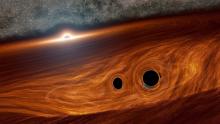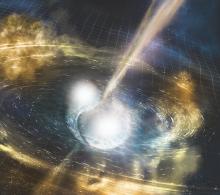Listen to today's episode of StarDate on the web the same day it airs in high-quality streaming audio without any extra ads or announcements. Choose a $8 one-month pass, or listen every day for a year for just $30.
You are here
Back to Work
In 2011, MIT scientist Rainer Weiss was inspecting his brainchild: LIGO, an observatory for catching gravitational waves — tiny ripples in spacetime created by the motions of massive objects. It hadn’t yet found anything. But Weiss mused about what he hoped it would find.
WEISS: The thing that I’m hoping for — I hope I’m still alive when it happens — is that we detect a black hole either in its formation or in a coalescence of black holes. That, to me, would be the most remarkable output of this whole project.
LIGO hasn’t caught the birth of a black hole, but it has discovered 90 gravitational-wave events — almost all of them the mergers of black holes. The discoveries confirmed the existence of black holes and gravitational waves. And they earned Weiss and two colleagues the 2017 Nobel Prize in Physics.
The observatory has two sites, one in southern Washington and the other in Louisiana. They use long vacuum tunnels, lasers, and ultra-precise mirrors to “hear” the waves, which are smaller than the particles in the nucleus of an atom.
LIGO shut down when Covid hit, but it’s ready to get back to work this month. It’s been upgraded, making it much more sensitive. And it’ll team with observatories in Japan and Italy, making it even more sensitive. So scientists expect to find many more merging black holes and other objects, out to ranges of billions of light-years — remarkable discoveries from a prize-winning observatory.
Script by Damond Benningfield





